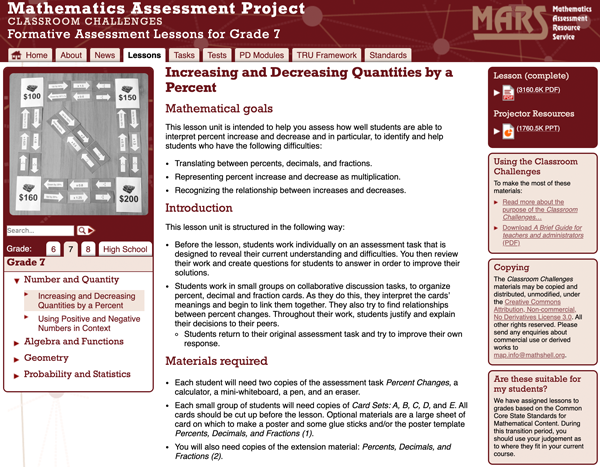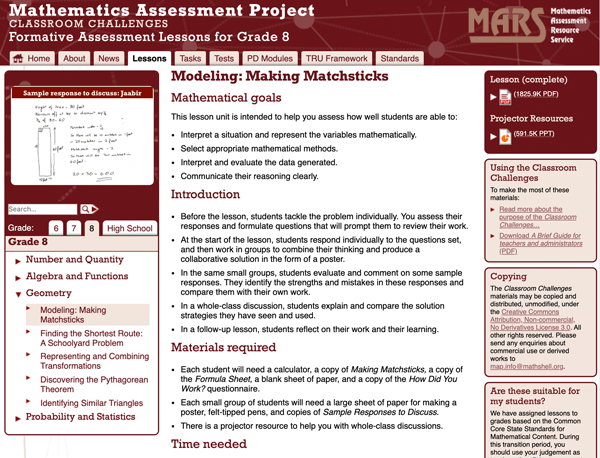30 Design Strategies and Tactics from 40 Years of Investigation
Appendix: Further information and examples
‘Common issues’ tables
These are designed to help teachers with challenges that occur amid the minute-by-minute pressures of the classroom.
Concept-focussed lessons

Link to materials
In lessons focused on concept development, one of these challenges is recognizing the understandings and misconceptions of individual students working on a task, the other is to devise or choose appropriate interventions. One natural response is to rapidly re-teach the part of the topic that seems to be causing difficulty; not only is this ineffective (the student misunderstood the first, more careful explanation) but it takes the thinking away from the student. Rather than teacher explanations, appropriately-designed questions can be more effective in moving student thinking forward without taking over the students' thinking. Such non-directive questions are not so easy to devise in real time.
The common issues table outlines the main misconceptions, which emerge from prior research and development, and suggests questions for each.
This is part of the table for Increasing or decreasing numbers by a percentage – one of the Formative Assessment Lesson Units from the Mathematics Assessment Project.
| Common issues | Suggested questions and prompts |
|---|---|
|
Makes the incorrect assumption that a percent increase/decrease means the calculation must include an addition/subtraction For example: 40.85 + 0.6 or 40.85 + 1.6 (Q1). A single multiplication by 1.06 is enough. Or: 56.99 − 0.45 or 56.99 − 1.45 (Q2). A single multiplication by 0.55 is enough. |
|
|
Converts the percent to a decimal incorrectly For example: 40.85 × 0.6 (Q1). |
|
|
Uses an inefficient method For example: The student calculates 1%, then multiplies by 6 to find 6% and then adds this answer on: (40.85 ÷ 100) × 6 + 40.85 (Q1). Or: 56.99 × 0.45 = ANS, then 56.99 − ANS (Q2). A single multiplication is enough. |
|
|
Is unable to calculate percent change For example: 450 − 350 = 100% (Q3). Or: The difference is calculated, then the student does not know how to proceed or he/she divides by 450 (Q3). The calculation (450 − 350) ÷ 350 × 100 is correct. |
|
|
Subtracts percents For example: 25 − 20 = 5% (Q4) Because we are combining multipliers: 0.8 × 1.25 = 1, there is no overall change in prices. |
|
|
Fails to use brackets in the calculation For example: 450 – 350 ÷ 350 × 100 (Q4). |
|
|
Misinterprets what needs to be included in the answer For example: The answer is just operator symbols. |
|
Problem solving lessons

Link to materials
In problem-solving lessons, the initial emphasis is on the choice of how to tackle the problem – the strategy and tactics of formulating an approach. A range of issues flow from this. Below is part of the table for Matchsticks:
| Common issues | Suggested questions and prompts |
|---|---|
|
Has difficulty getting started |
|
|
Ignores the units For example: The student calculates the volume of a matchstick in cubic inches and the volume of the tree trunk in cubic feet. |
|
|
Makes incorrect assumptions For example: The student multiplies the volume of the tree trunk in cubic feet by 12 and assumes this gives the volume of the tree trunk in cubic inches. |
|
|
Uses an inappropriate formula For example: The student calculates the surface area of a rectangular prism from the dimensions given for the tree. |
|
|
Works unsystematically |
|
|
Work is poorly presented For example: The student underlines numbers and it is left to the reader to work out why this is the answer as opposed to any other calculation. |
|
|
Difficulty substituting into a formula For example: The student multiplies the radius by 2, rather than squaring, when using the formula for the volume of a cone/cylinder. Or: The student substitutes diameter rather than radius into the formula for the volume of a cone/cylinder. |
|
Links to materials:
- MAP – Increasing and decreasing by a percentage
- https://www.map.mathshell.org/lessons.php?unit=7100&collection=8
- MAP – Making Matchsticks
- https://www.map.mathshell.org/lessons.php?unit=8300&collection=8